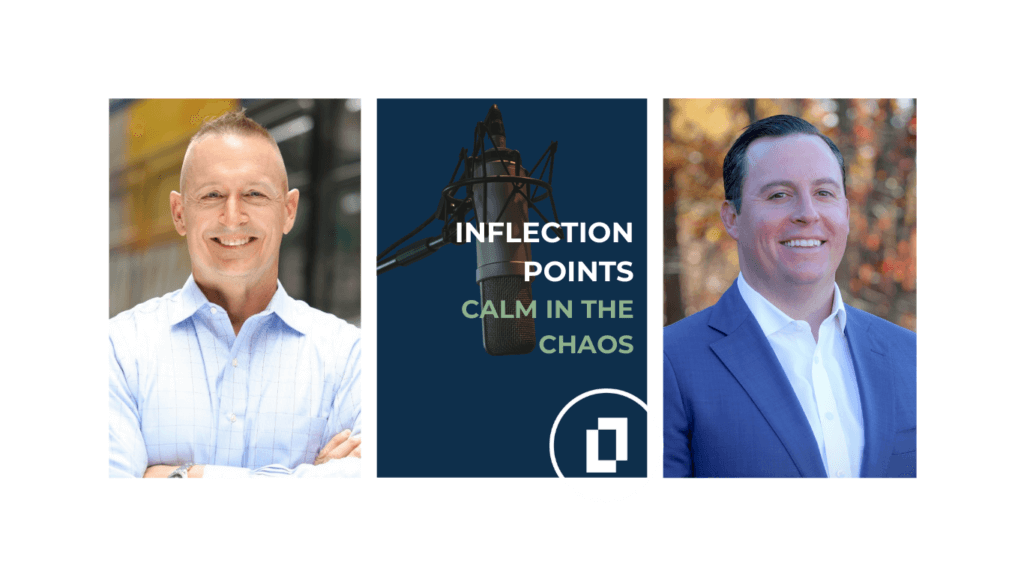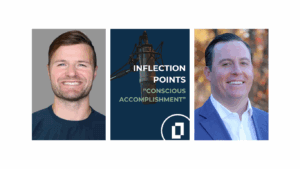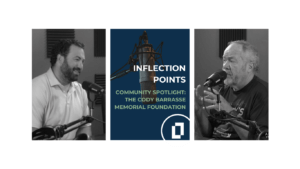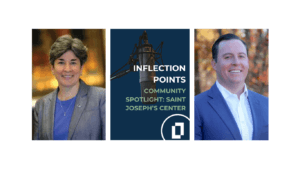
Inflection Points: “Calm in the Chaos”- 10 Questions with Performance Coach John Burns
Inflection PointsApr 23, 2025
In an effort to bring useful information to clients in different ways, we’re adding written interviews to complement our long-form podcast. This edition features John Burns, a Performance Coach who has worked with everyone from hedge fund managers and executives to NASCAR pit crews and major league baseball players. His goal with clients is to help them unlock high performance and make better decisions in high pressure situations.
Recently, Senior Wealth Advisor Mike Cordaro sat down with John for a ten-question interview. They covered today’s volatile market environment, how John helps clients make better decisions, and even found time to talk a bit about the Masters and golf.
Cordaro: You spent 17 years as a floor trader at the Chicago Mercantile Exchange. What did that environment teach you about staying calm and making smart decisions when everything around you is insane—kind of like right now?
Burns: Thinking back on my time on the floor recently caused me to change the name of my Substack page to Chaos is my calm.
One event that stands out happened in the early 2000s during a mad cow outbreak, which massively impacted the market I traded—Feeder Cattle Options. Prices went limit down for an entire week. (Exchanges set price limits to help prevent panic-driven collapses.) It was one of the most extreme markets I experienced, and it taught me several lasting lessons:
First, always make sure you can trade tomorrow. Managing risk is not about maximizing today’s gain—it’s about preserving the ability to keep going.
Second, understand your exposures. Risk often hits fast and feels very different in real time than it does when you analyze it in theory. Risk is as unique as a fingerprint, so we all have different risk tolerances. When risk is happening, the market doesn’t wait for you to get comfortable.
Third, trying to change your emotional state in the middle of chaos wastes precious energy. Emotions are information. Once I learned to pause and understand what a feeling was trying to tell me, the emotional charge would often dissolve. Fear, frustration, even panic—those are natural responses when risk hits. The key is not to resist them but to embrace them.
Finally, know your own patterns. I thrived in volatile, fast-moving markets. But I realized over time that I loved chaos so much that I was often slow to shift when the market calmed down. That meant I was late in adjusting my positions and strategy. Loving chaos is a strength, but it can also become a blind spot.
Cordaro: How do you help people separate signal from noise—especially when the pressure’s high and there’s too much coming at them at once?
Burns: I start by tuning into both what someone is thinking and what they’re feeling. And then I ask questions—not to give answers, but to help them clarify their own thoughts. Just saying something out loud can be powerful. But saying it to someone whose only job in that moment is to really listen? That’s where discernment starts.
When thoughts stay trapped in our heads, they just bounce around in the echo chamber of our minds. But once they’re spoken, especially in the presence of someone actively listening, they become easier to examine. They lose some of that mental fog.
Often, I’ll repeat back what I heard a client say—and it’s not uncommon for them to respond, “No, that’s not quite what I meant.” And that’s the moment we want. That’s where we slow down, dig in, and really work to find the words that actually reflect what’s true for them.
That process—bridging what you feel internally with what you express externally—creates clarity. It’s where signal starts to emerge from all the noise. And from there, decision-making gets sharper, more grounded, and way more aligned with who they are and what they want.
Cordaro: Something that stuck out to me in your work is that you talk about using emotions as data. That’s not how most people think—many even ignore or misidentify emotions. What does that actually mean?
Burns: Yeah, that’s a big one. Culturally, we’re often taught to push emotions aside. You know, “Boys Don’t Cry”—which, by the way, is one of my favorite Cure songs. But more broadly, we’re told that emotions are irrational, messy, and not to be trusted. And that conditioning sticks.
But here’s the truth: Decision-making research shows that we can’t make decisions without emotion. Our brains are constantly predicting what will happen next based on past experiences—basically, our memories—and the way those experiences felt in our bodies. That emotional data is built into every choice we make, whether we realize it or not.
So, when I say emotions are data, I mean they give us real-time feedback. They’re signals. The problem is, most people either try to ignore them, suppress them, or only chase the “positive” ones. But trying to stuff emotions down is like holding a balloon underwater—it’s gonna pop back up, just not where or when you expect it.
One key thing I work on with clients is separating emotion from action. Feeling fear, anger, or sadness doesn’t mean you have to act on it immediately—or at all. But it does mean something’s going on under the surface. And if you can get curious about it instead of fighting it, you can actually use that emotional energy to make better predictions and decisions going forward.
Cordaro: What does it look like in practice when someone is trying to make a big life or career decision?
Burns: First, I always start by trying to understand the thoughts and feelings wrapped up in the decision. What are they hoping this decision will actually change? And just as important—what do they think they’ll feel once it does?
Because big decisions usually come with a kind of fantasy or prediction attached. Whether it’s a career switch, a move across the country, or stepping into a bigger leadership role, there’s often this imagined version of how life will feel afterward. And I want to help them explore not just the logistics, but whether that imagined future actually lines up with what’s likely.
There’s also a shift in identity that comes with major change. What it feels like to be you after the decision might feel different from what was felt after the decision, and that can be unsettling, even if the change is technically positive.
One practical tool I use a lot is mapping out best case, worst case, and most likely scenarios. It sounds simple, but it helps open up the field of view. When a big opportunity comes with shiny perks, people can get tunnel vision. Seeing the full range of outcomes keeps the process grounded and realistic.
Ultimately, my job isn’t to tell someone what to do—it’s to help them feel all the parts of the decision. At times, emotions from the past show up in the present and distort things. That’s when the waters get muddy.
One lens I use to make sense of that is Neuropsychoanalysis. It’s a way of integrating brain science and psychoanalytic thinking, especially how the brain predicts what will happen based on past experiences. I pull from frameworks like the Free Energy Principle, which helps explain how we try to minimize surprise and uncertainty. When clients start to understand how their mind and body are working together to shape their decisions, they can choose with more clarity—and more alignment between their values, their goals, and their emotional truth.
Cordaro: What’s one misconception people have about high performance under pressure that you see over and over again?
Burns: One of the biggest ones is the idea that you should just “treat it like any other day.” But high-pressure, high-consequence moments aren’t just another day. They feel different—and that difference matters.
There’s a great scene in Hoosiers where Gene Hackman walks his small-town team into this massive gym for the state tournament. He takes out a tape measure, checks the free-throw line and the basket, and says, “See? Same as our gym back home.”
Technically, he’s right. But emotionally? It’s a totally different game. Now you’ve got five times the crowd, unfamiliar opponents, higher stakes—and a level of pressure you haven’t practiced for.
That’s the point. Big moments are different. And pretending they’re not? That’s when strange performance challenges show up. Take Rory McIlroy at the Masters—he hit a wedge from 53 yards into the water. He’s one of the best in the world, but to me, that shot looked like someone was trying to downplay the moment rather than acknowledge and accept it. It worked out in the end, but it didn’t need to be that dramatic.
What I work on with clients is helping them acknowledge the size of the moment, not fear it, not inflate it, but respect and accept it. When that is done, it actually gives the best shot at being fully present, fully prepared, and able to perform optimally when it matters most.
Cordaro: The example of Rory at the Masters is really interesting. While we are on the topic, tell us about your journey with golf and what the game has taught you about how to think and perform under pressure.
Burns: Golf is where my journey into mental performance really began. When I started taking the game seriously—especially tournament play—I realized I wanted to use my mind more intentionally. I wanted to play better under pressure, and golf gave me the perfect training ground.
I’ve been fortunate to win my club championship a few times. What really stood out to me over those years was how much desire, pressure, and expectation can shape performance. There was one guy at my club—a very good player— during the regular season, he’d beat me pretty often. But in the club championship, it was a different story. We played each other multiple times, and it became clear that even though he was talented, he wasn’t going to beat me in that setting.
At the time, I didn’t fully understand why. But looking back, part of it came down to how I respond to pressure. I love big moments. I lock in, my focus sharpens, and the noise fades. That intensity became part of how I saw myself—not just in golf but in trading, coaching, and many other high-stakes arenas. It’s like a superpower. Others responded by becoming overwhelmed by the pressure of situations and wanted to do things to lessen the feelings that accompany pressure.
But like any superpower, it comes with a downside. That same laser focus that helps in competition can also make me tune out other important areas of life. So part of the journey has been learning how to dial it up when needed—and how to dial it down when it’s not.
Golf’s also taught me the value of knowing your stats. I love stats—whether it’s golf, trading, or baseball. Numbers help you see where your strengths are, but more importantly, where you’re leaving strokes—or opportunities—on the table. I tell clients all the time: if there’s resistance to looking at an area that clearly needs work, there’s usually something emotional or mental underneath that.
Cordaro: Not to get off track here, but any tips for lowering your handicap this year?
Burns: Start by noticing if any consistent thoughts and emotions come up. I always had signs of nerves after my first tee shot. Do some shots feel different than others? Do bunkers terrify you? That’s ok, just starting to recognize, accept, and understand can go a long way. In addition, start to really track your game—greens in regulation, putts per round, up-and-down percentage. Find that one area that’s lagging and get curious about it. Sometimes, just noticing what’s holding you back can start to shift things.
Cordaro: How do you coach someone who’s stuck—not because they don’t know what to do, but because they’re afraid of what might happen if they actually go for it?
Burns: Yeah, this comes up all the time. The truth is, change is hard—even when it’s the change we say we want. So when someone’s stuck, I’m less focused on the surface-level goal and more curious about what’s going on underneath the hesitation.
One thing I look for is what’s called secondary gain. Basically: what are they unconsciously getting out of staying stuck? Sometimes there’s a belief deep down that they don’t deserve what they’re going after—or that actually achieving it might bring a whole new set of problems that feel scarier than staying where they are.
So we slow things down and start asking: What’s the real fear here? What emotion is sitting at this decision point? This can happen when a past emotion takes over the present moment and becomes fused with action. The feeling and action stay stuck together until we can untangle them through understanding what the historical feeling is and why it came up and influenced the action.
I wrote a blog about this using the example of Steve Sax—the former MLB second baseman who suddenly developed the yips. He couldn’t make a routine throw to first base. Physically, he was fine. But emotionally? Something had gotten so tangled in that motion that his body basically said, “Nope, we’re not doing this.”
That’s an extreme case, but honestly, most people experience their own version of that. They know what they want to do—but something inside just won’t let them. My job is to create a space where they can actually say it out loud—to someone who’s not judging, not rushing to fix it, just fully present with them.
And often, when the emotion gets acknowledged and accepted that way, it loosens its grip. Then we’re not pushing through fear—we’re moving forward with clarity and choice, because they’ve finally made sense of what was holding them back.
Cordaro: You’ve worked with people and teams in some of the most high-stakes environments out there. What have you learned about building trust and communication under pressure?
Burns: One of the most impactful experiences I’ve had was working with a couple of NASCAR pit crews—William Byron’s and Chase Elliott’s teams—for a few years. These are incredibly high-performing, high-pressure teams. And one of those years was during COVID, which brought its own layer of complexity.
What stood out to me was how committed every single person on the crew was to not being the weak link. They knew that when racing resumed, the margin for error would be even smaller. So they all raised their standards—not just individually, but collectively. That shared standard, where everyone’s accountable to each other, not just for themselves—that’s a huge trust builder.
Something else I learned from those teams: they only got faster when they got better together. If one crew member suddenly got way faster than the rest, the team actually slowed down. Why? Because the rhythm was off. The whole crew is like a living organism, and when flow is disrupted, everyone has to shift from unconscious competence back to conscious competence—which is slower and more error-prone.
So when we talk about trust and communication under pressure, the foundation is technical trust. You have to believe your teammate knows what they’re doing. Once that’s solid, then real communication can begin—especially around feedback.
And feedback is tricky. High performers are proud of their craft. They’re precise. So feedback can easily feel personal—even when it’s not meant that way. That’s why I emphasize being specific when giving feedback. Keep it about the action, not the person.
When it comes to receiving feedback, I encourage people to start from the assumption that what their teammate is saying is accurate. Take it in, sit with it, and then assess it: Does this sound true? Does it feel true? Does that sound like me? From there, you can go back to the teammate or the team and have a real conversation—one that leads to alignment, not defensiveness.
That kind of open, skillful feedback loop is one of the strongest signs of trust. And it’s what allows high-stakes teams to keep improving, especially when the pressure’s on. It is not easy since everyone needs to be focused on the shared goal of the team.
Cordaro: If someone listening is facing a major decision right now—career, family, life—what’s one question they should ask themselves before making the next move?
Burns: One powerful question is: What would actually change if I made this decision? Not just the big-picture outcome, but the day-to-day reality. How would it affect your routine, your relationships, your energy, your sense of purpose?
I also encourage people to ask, Why is this important to me? and Does it align with my values and the kind of life I want to build—for myself and the people I care about?
Then take it a step further: project out one year, five years, even ten years. What does life look like if you make the move? What if you don’t? That kind of future pacing can reveal a lot.
And finally, ask yourself: What’s the real conflict underneath this decision? Often, there’s a tension between what we want and what we fear. That’s where the real work is.
When I’m working with clients, I think of myself as a bit of a counterpuncher. I follow their lead and respond to what shows up—in their thoughts, in the emotional shifts, in how they respond, as well as thoughts and images that come up to me, because that’s where the real clarity lives.
Cordaro: Finally, this is always my last question for guests—Given all your experiences to this point in your life, what advice would you give your 22-year-old self?
Burns: I’d tell him: Enjoy the ride. Be serious but not too serious. Be all in on working towards goals, but also be all in on having fun. Mess around, laugh more, and don’t take everything so personally.
I’d remind him to be kind to himself. The weight of the world? That’s not his to carry alone. Stay curious, build experiences—with people, with places, with life. And honestly? Play more golf. It teaches you almost everything you need to know about pressure, patience, and joy.
Disclosures: Alliance Wealth Advisors, LLC (“Alliance”) is an SEC Registered investment advisory firm that is independently owned and operated. The information in this interview is provided for informational purposes only and should not be taken as investment, legal, or tax advice. Opinions expressed in this interview are subject to change without notice. It is important to remember that investments in securities involve risk, including the potential loss of principal invested. Past performance is no guarantee of future results and diversification does not guarantee a profit or protect against loss in a declining financial market. Alliance does not guarantee the suitability or potential value of any particular investment or strategy and accepts no liability for reliance on this presentation. Alliance also does not make any representations as to the accuracy, timeliness, suitability, completeness, or relevance of any information prepared by any unaffiliated third party mentioned in this communication and takes no responsibility. Our guest and was not a client of Alliance Wealth Advisors at the time of this publication, did not receive any compensation for this interview, not otherwise affiliated with, the firm and not client of Alliance Wealth Advisors at the time of this publication. For more information regarding Alliance, please visit alliancewealthadvisors.com/legal-disclosures.


